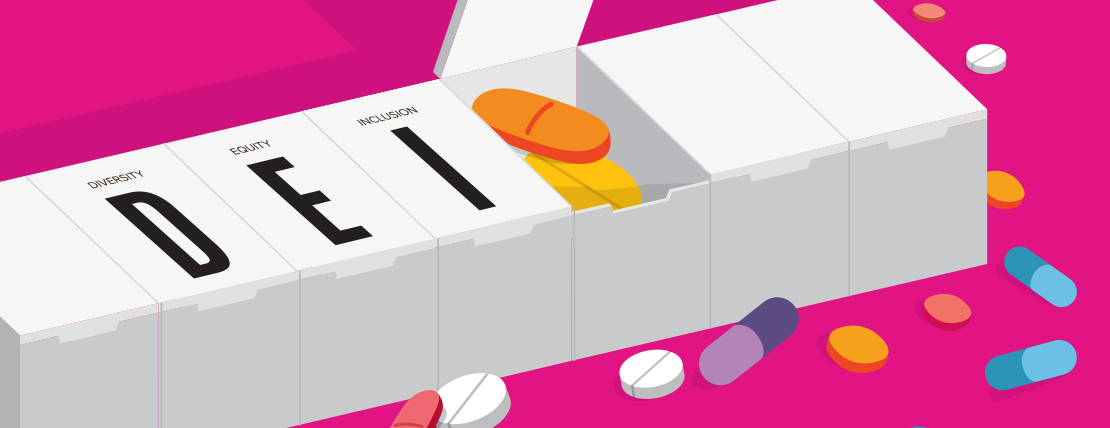Today’s diverse workforce includes multiple generations, races, religions, ethnic backgrounds and gender identities. Employers recognize the value of a diverse workforce to drive innovation. To facilitate an inclusive workplace, companies often establish employee resource groups (ERGs) around diversity classifications. Unfortunately, one group remains unrepresented: employees who struggle with addiction.
These employees are often ignored, excluded and afraid to seek help for fear of losing their jobs. Therefore, they suffer in silence, which leads to low productivity and morale, turnover, absenteeism, rising insurance costs, sexual harassment, accidents and theft.
The American Medical Association considers addiction a chronic — yet treatable — medical condition, like diabetes and heart disease. Addiction is a rising threat in the workplace, and is a critical diversity, equity and inclusion (DEI) issue that HR must play an important role in addressing.
No Quick Fix
Seventy percent of employees who misuse alcohol or drugs are employed either full or part-time, according to SAMHSA. A Hazelden Betty Ford Foundation survey found that 67% of HR professionals believe substance use is one of the most serious issues facing the workforce. Consequences include absenteeism, reduced productivity and a negative impact on corporate reputation.
I recently interviewed several HR practitioners to learn more about their challenges. One associate told me about an employee who needed an employee assistance program (EAP) referral because of a child’s fatal drug overdose.
Another employee was involved in a job-related automobile accident while high on alcohol and marijuana. A recruiter reported that her company is a federal contractor (a drug-free workplace), and is losing good candidates because they cannot pass the pre-employment drug screen because of legalized marijuana. Another HR person asked how to identify signs of substance misuse. These examples of alcohol- and drug-related issues are not isolated events.
When instances of substance misuse occur in the work- place, they are typically dealt with according to company policy because they can pose a serious risk of liability to the business. Except for ‘pre-employment’ drug screens, HR’s involvement is reactive to a workplace incident, accident or performance decline requiring intervention, versus proactive or preventive.
"Not all employees who have an alcohol/drug problem are disciplined, terminated or offered help. Many need help for issues that are hidden or ignored."
Here’s another workplace reality — not all employees who have an alcohol/drug problem are disciplined, terminated or offered help. Many need help for issues that are hidden or ignored.
Today’s society respects an individual’s right to use mood-altering substances. Users and misusers come from every socioeconomic and demographic group imaginable. According to a 2019 report issued by the U.S. Government’s Substance Abuse and Mental Health Services Administration (SAMHSA), an estimated 165.4 million people in the U.S. use substances such as tobacco, alcohol or illicit drugs.
An estimated 139.7 million Americans drink alcohol (slightly more than half of the population). They are our spouses, partners, parents, and other family members and friends.
Besides alcohol, 57.2 million people use illicit drugs. More than 26% of employed adults have substance abuse or addiction in their family. Many of these people could be a past, present or future employee of your company or could be related to one.
Sober Curious Champions
There is some more encouraging news: 22.35 million people in the U.S. are in recovery from an alcohol or drug problem, representing 9.1% of the adult population.
Many in the workforce are eager to engage with others around these sensitive issues. They are available to promote awareness education, provide information on resources and serve as a point of contact for individuals interested in learning about the ‘sober curious’ movement.
Some champions are qualified to support these activities because of their lived experience or because they have worked as recovery peer supporters or professional recovery coaches.
So why aren’t some businesses capitalizing on supporting employees in recovery? Beth Siegert, owner of Siegert & Associates, points to the stigma associated with substance abuse and mental health as one primary reason why these issues were rarely discussed and why supporting recovery in the workplace was not offered on a broader basis in the past.
However, now that mental health and substance misuse are openly discussed, HR has not kept pace, said Siegert.
“This is even more surprising, as DEI is an increasingly valued contribution from HR. Some changes to culture have traditionally been ignored, including substance use in the workplace, while some large tech firms are actually allowing employees to openly use alcohol during work. While these businesses support drinking on the job, HR could and should be supporting diversity by engaging professionals to help break the silence and normalize recovery as part of a healthy workplace.”
Enrique (Henry) Fiallo, a former executive for several large companies and a certified professional life and recovery coach, urges senior leaders to set the tone in terms of workplace culture and the use of alcohol and other substances.
“EAP programs are mostly for show and in many ways a hypo- critical response to the real problem,” Fiallo said. “Traditionally, companies establish EAPs that offer a few counseling sessions, after which the employee is on their own to seek treatment/ counseling and deal with stigma and consequences of their addiction.”
Some companies still encourage happy hours and functions that include the serving of alcohol and an atmosphere of letting loose inhibitions and restraints, said Fiallo, who admits that, in his former CEO role, he encouraged and participated in this kind of behavior, which led to his own battle with alcohol and related personal behavioral challenges.
“Substance abuse is everybody’s problem and requires awareness, commitment and support across the entire organization. It’s good for business and the right thing to do.”
“Substance abuse is everybody’s problem and requires awareness, commitment and support across the entire organization. It’s good for business and the right thing to do.”
Out on the Front Lines
COVID-19’s impact on the workforce has been devastating. Behavioral health service providers know isolation, fear, stress, unemployment and economic uncertainty increase anxiety and depression, and contribute to addiction, which when undiagnosed can result in death.
Since the onset of COVID-19, there has been a dramatic increase in demand for EAPs. In fact, a recent American Psychological Association article describes the ongoing stress and uncertainty related to the coronavirus as the “pandemic within the pandemic.” Studies show an unprecedented rise in mental health issues, increased misuse of alcohol and substances and deaths from drug overdoses and suicide, directly or indirectly linked to COVID-19.
When considering the pandemic’s impact on the workforce, Psychology Today cited a national survey conducted by McKinsey & Company. Of 1,000 employers surveyed, 90% stated COVID-19 has had a negative effect on workforce productivity, while 80% of respondents stated that they were “concerned” or “very concerned” about the impact of substance misuse among their employees.
The concern is justified, said Tiffany Swedeen, RN, BSN, a former intensive care unit nurse at Providence Regional Medical Center Everett in Everett, Wash., and author of multiple Working Nurse articles on her experiences working on the front lines of the pandemic.
Swedeen is also in recovery from an alcohol and opioid use disorder and has written and spoken extensively about her recovery journey (When the Nurse is an Addict: Part One and Part Two).
As a person under pressure on the front lines, she needed support to manage the overwhelming stress. Swedeen endured a litany of difficulties involved in trying to access, use and help others obtain services through her company’s caregiver assistance program (CEAP).
Swedeen is a workplace “champion” who sought to advocate on behalf of herself and co-workers. In response to her efforts to draw attention to the difficulties trying to access needed services, she was told by HR they should “know the services are there and just use them.”
“This is a pandemic that’s beyond anything you will ever experience,” she said. “Therapists themselves needed therapy this year, and we [the nurses] felt desperately needed and totally replaceable at the same time.”
Swedeen and her co-workers are not alone. A recent Washington Post article reported three in 10 health-care workers are considering leaving the profession after experiencing a year of overwhelming trauma.
New Paths Forward
Like Swedeen, there are many corporate leaders who can become champions willing to advocate for new solutions to employee alcohol or drug misuse. One solution is the expansion of existing DEI efforts to meet the needs of employees seeking support regarding for alcohol and substance use.
In a 2015 re:Work With Google blog, Paul Santagata reported on the results of a two-year Project Aristotle study to determine what motivates the most effective teams. The study revealed the highest-performing teams share “psychological safety.”
The Center for Creative Leadership defines psychological safety as “a shared belief held by members of a team that others on the team will not embarrass, reject or punish you for speaking up. When you have psychological safety in the workplace, people feel comfortable being themselves,” said David Altman, the Center’s chief operating officer.
This same concept exists as a guiding principle of employee resource groups (ERGs) or affinity groups. According to DiversityInc, these groups advocate for employees to be their best authentic selves at work. They bring together employees who have similar interests or backgrounds. While sanctioned by the corporation, they are primarily employee-led groups.
These groups offer many benefits to the company and members. The groups are increasingly referred to as business resource groups because their contribution to the workplace helps the company attract and retain talented employees, positively impact the bottom line and improve employee morale and workplace culture.
Workplace discussions related to national politics, the #MeToo movement and social-justice issues have accelerated the need to provide safe spaces for workers to have respectful and honest conversations. These conversations can be uncomfortable, but are critical in achieving workplace inclusion.
And it is this position that provides the most solid business case for an expansion of the DEI/ERG tent to make room for otherwise hiding or silent employees needing support and desiring their voices to be heard as it relates to alcohol and substance abuse issues.
The final pathway addresses the company’s need to create strategic partnerships with individuals or organizations that are qualified and capable of supporting the organization’s efforts to break the silence and explore a new vision regarding employee use of alcohol and other substances.
This effort is important for two main reasons. First, few HR professionals are trained to deliver addiction recovery aware- ness education programs or to provide support to employees beyond what is made available through the traditional HR practices mentioned previously. Second, there is an inherent lack of trust on the part of the workforce when discussing alcohol or drug use with HR or other managers.
For this reason, HR must have the ability to connect with other professionals or organizations better suited to directly support the workforce (bypassing HR), and perhaps coordinated by the ERGs or other means.
“When you have psychological safety in the workplace, people feel comfortable being themselves.”
Connections to trained and certified addiction and recovery professionals can be made through existing partnerships with legal, health and wellness, benefits or EAP service providers. Companies can also obtain support from new specialized service providers such as certified professional recovery coaches or certified facilitators in addiction awareness.
Psychology Today refers to a “coming revolution” in the workplace in terms of employee mental health. And, because mental health, alcohol and substance abuse often occur simultaneously, the revolution necessitates a workplace evolution with respect to the way companies address alcohol, substance misuse and addiction.
Companies that demonstrate leader- ship by expanding their DEI initiatives in response to the needs of employees struggling with substance misuse, addiction or other behavioral health issues will see positive impact to their key performance indicators (KPIs), become recognized as an employer of choice among employment candidates, and increase their brand recognition among all stakeholders who value employee health and well-being.








